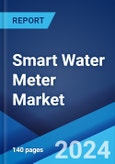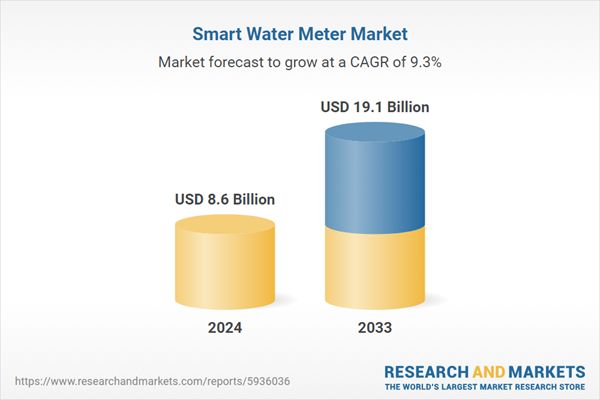The global smart water meter market size reached USD 8.6 Billion in 2024. Looking forward, the publisher expects the market to reach USD 19.1 Billion by 2033, exhibiting a growth rate (CAGR) of 9.3% during 2025-2033. The market is experiencing steady growth driven by the growing concerns about water scarcity due to population growth, urbanization, and climate change, regulatory mandates and government policies to promote water conservation, and rising need for efficient water management.
The market research report has provided a comprehensive analysis of the competitive landscape. Detailed profiles of all major companies have also been provided.
2. What is the expected growth rate of the global smart water meter market during 2025-2033?
3. What are the key factors driving the global smart water meter market?
4. What has been the impact of COVID-19 on the global smart water meter market?
5. What is the breakup of the global smart water meter market based on the product?
6. What is the breakup of the global smart water meter market based on the meter type?
7. What is the breakup of the global smart water meter market based on configuration type?
8. What is the breakup of the global smart water meter market based on the component?
9. What is the breakup of the global smart water meter market based on the application?
10. What are the key regions in the global smart water meter market?
11. Who are the key players/companies in the global smart water meter market?
Smart Water Meter Market Trends:
Growing water scarcity concerns
Water scarcity is a pressing global issue due to population growth, urbanization, and climate change. This concern is a significant driver for the smart water meter market. Smart water meters provide a solution to efficiently manage and conserve water resources. By offering real-time data on water consumption and leak detection, they empower utilities and consumers to take proactive measures to reduce water wastage. Governments and regulatory bodies worldwide are increasingly advocating for the adoption of smart water meters to address water scarcity challenges. This, in turn, is propelling the growth of the market, especially in regions prone to water shortages, as it aligns with sustainability goals and promotes responsible water management practices. As water scarcity is increasing, the demand for smart water meters is rising, making them a vital tool in ensuring sustainable water usage.Regulatory mandates for water conservation
Regulatory mandates and government policies aimed at promoting water conservation play a crucial role in driving the smart water meter market. Many countries and regions are implementing strict regulations to monitor and reduce water consumption, especially in urban areas facing water stress. Smart water meters enable compliance with these regulations by providing accurate and timely data on water usage. They also facilitate fair billing practices, as consumers are billed based on their actual consumption, discouraging wasteful usage. In response to these regulatory pressures, utilities and municipalities are increasingly adopting smart water metering solutions to ensure compliance, avoid penalties, and demonstrate their commitment to sustainable water management. In addition, the need for regulatory compliance and the drive toward responsible water usage is impelling the growth of the market.Efficient water management for utilities
The need for efficient water management is catalyzing the demand for smart water meters, particularly for water utilities and municipalities. Smart water meters offer utilities a powerful tool to optimize their operations and resources. These meters provide real-time data on water consumption, enabling utilities to detect leaks, identify unusual usage patterns, and plan maintenance more effectively. This leads to reduced water losses, lower operational costs, and improved service reliability. Additionally, the data collected by smart water meters can be used for demand forecasting, infrastructure planning, and informed decision-making. As utilities are striving to provide reliable water services while minimizing waste and operational expenses, the adoption of smart water meters is becoming increasingly appealing. Thus, the pursuit of efficient water management is bolstering the growth of the market.Environmental sustainability initiatives
Environmental sustainability initiatives, both from public and private sectors, are driving the adoption of smart water meters. As people are becoming more conscious of environmental issues, there is a growing emphasis on reducing water wastage and conserving this precious resource. Smart water meters play a pivotal role in achieving these sustainability goals. They enable consumers to monitor their water usage in real-time, promoting conscious consumption and reducing water wastage. Additionally, by swiftly detecting leaks and irregularities, smart water meters prevent water loss, which aligns with sustainability objectives.Smart Water Meter Industry Segmentation:
The publisher provides an analysis of the key trends in each segment of the market, along with forecasts at the global, regional, and country levels for 2025-2033. Our report has categorized the market based on product, meter type, configuration type, component, and application.Breakup by Product:
- Electromagnetic Meter
- Ultrasonic Meter
- Electromechanical Meter
- Others
Electromechanical meter accounts for the majority of the market share
The report has provided a detailed breakup and analysis of the market based on the product. This includes electromagnetic meter, ultrasonic meter, electromechanical meter, and others. According to the report, electromechanical meter represented the largest segment as these traditional meters are evolving to incorporate smart features, such as automated data collection and remote monitoring. They use mechanical components to measure water flow, making them robust and reliable. Their widespread use in existing infrastructure and their gradual transition to smart technology contribute to their dominance in the market. They are often preferred for retrofitting older water meter systems, ensuring compatibility and ease of integration with legacy systems.Breakup by Meter Type:
- Smart Hot-Water Meter
- Smart Cold-Water Meter
Smart cold-water meter holds the largest share in the industry
A detailed breakup and analysis of the market based on the meter type have also been provided in the report. This includes smart hot-water meter and smart cold-water meter. According to the report, smart cold-water meter accounted for the largest market share.Breakup by Configuration Type:
- Automated Meter Reading (AMR)
- Advanced Metering Infrastructure (AMI)
Automated meter reading (AMR) represents the leading market segment
The report has provided a detailed breakup and analysis of the market based on the configuration type. This includes automated meter reading (AMR) and advanced metering infrastructure (AMI). According to the report, automated meter reading (AMR) represented the largest segment.Breakup by Component:
- Meters & Accessories
- IT Solutions
- Communication System
Meters and accessories represent the leading market segment
The report has provided a detailed breakup and analysis of the market based on the component. This includes meters and accessories, IT solutions, and communication system. According to the report, meters and accessories represented the largest segment.Breakup by Application:
- Water Utilities
- Commercial
- Industrial
- Residential
Residential represents the leading market segment
The report has provided a detailed breakup and analysis of the market based on the application. This includes water utilities, commercial, industrial, and residential. According to the report, residential represented the largest segment.Breakup by Region:
- North America
- United States
- Canada
- Asia Pacific
- China
- Japan
- India
- South Korea
- Australia
- Indonesia
- Others
- Europe
- Germany
- France
- United Kingdom
- Italy
- Spain
- Russia
- Others
- Latin America
- Brazil
- Mexico
- Others
- Middle East and Africa
North America leads the market, accounting for the largest smart water meter market share
The market research report has also provided a comprehensive analysis of all the major regional markets, which include North America (the United States and Canada); Asia Pacific (China, Japan, India, South Korea, Australia, Indonesia, and others); Europe (Germany, France, the United Kingdom, Italy, Spain, Russia, and others); Latin America (Brazil, Mexico, and others); and the Middle East and Africa. According to the report, North America accounted for the largest market share.The market research report has provided a comprehensive analysis of the competitive landscape. Detailed profiles of all major companies have also been provided.
Some of the key players in the market include:
- Badger Meter
- Kamstrup A/S
- Diehl Stiftung & Co. KG
- Landis+Gyr
- Aclara Technologies LLC (Hubbell Incorporated)
- Sensus Worldwide Holdings Limited (Xylem Inc.)
- Itron Inc.
- Zenner International GmbH & Co. KG
- Neptune Technology Group (Roper Technologies)
Key Questions Answered in This Report
1. What was the size of the global smart water meter market in 2024?2. What is the expected growth rate of the global smart water meter market during 2025-2033?
3. What are the key factors driving the global smart water meter market?
4. What has been the impact of COVID-19 on the global smart water meter market?
5. What is the breakup of the global smart water meter market based on the product?
6. What is the breakup of the global smart water meter market based on the meter type?
7. What is the breakup of the global smart water meter market based on configuration type?
8. What is the breakup of the global smart water meter market based on the component?
9. What is the breakup of the global smart water meter market based on the application?
10. What are the key regions in the global smart water meter market?
11. Who are the key players/companies in the global smart water meter market?
Table of Contents
1 Preface3 Executive Summary13 Value Chain Analysis15 Price Indicators
2 Scope and Methodology
4 Introduction
5 Global Smart Water Meter Market
6 Market Breakup by Product
7 Market Breakup by Meter Type
8 Market Breakup by Configuration Type
9 Market Breakup by Component
10 Market Breakup by Application
11 Market Breakup by Region
12 SWOT Analysis
14 Porters Five Forces Analysis
16 Competitive Landscape
List of Tables
Companies Mentioned
- Badger Meter
- Kamstrup A/S
- Diehl Stiftung & Co. KG
- Landis+Gyr
- Aclara Technologies LLC (Hubbell Incorporated)
- Sensus Worldwide Holdings Limited (Xylem Inc.)
- Itron Inc.
- Zenner International GmbH & Co. KG
- Neptune Technology Group (Roper Technologies)
Methodology

LOADING...
Table Information
| Report Attribute | Details |
|---|---|
| No. of Pages | 134 |
| Published | January 2025 |
| Forecast Period | 2024 - 2033 |
| Estimated Market Value ( USD | $ 8.6 Billion |
| Forecasted Market Value ( USD | $ 19.1 Billion |
| Compound Annual Growth Rate | 9.3% |
| Regions Covered | Global |
| No. of Companies Mentioned | 9 |









